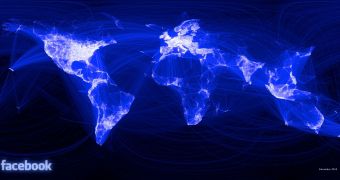Like they say, a picture is worth a thousand words and this is true when dealing with data as well. Understanding how people form relationships on Facebook in different cities and across countries is a daunting task considering there are well over 500 million Facebook users in the world.
A visualization should prove much useful than the raw data, but even this is not easily achieved, as Facebook intern Paul Butler found when he set out to create a visual representation of the way Facebook friends connect across distances.
"When the data is the social graph of 500 million people, there are a lot of lenses through which you can view it. One that piqued my curiosity was the locality of friendship," Butler writes.
"I was interested in seeing how geography and political borders affected where people lived relative to their friends. I wanted a visualization that would show which cities had a lot of friendships between them," he explained.
But this would not prove easy. Using a sample of 10 million users he plotted the relationships between each pair of cities. Using the open-source data analysis tool R he simply instructed it to draw lines between the connected cities.
But even with 10 million users, a rather small sample compared to the total number of Facebook users, there was simply too much data and it overwhelmed the visualization.
Butler figured that stronger relationships had to be emphasized over looser ones. Each line between two cities was given a weight depending on the distance between them and the number of friends connecting. The weight was then used for the intensity of the line.
The result is a representation of our world based on Facebook relationships. While it's interesting to see all of the connections between even the most remote cities, the image also shows where Facebook is the most popular. Russia and China are rather dark when compared to regions like the US and much of Europe.

 14 DAY TRIAL //
14 DAY TRIAL //